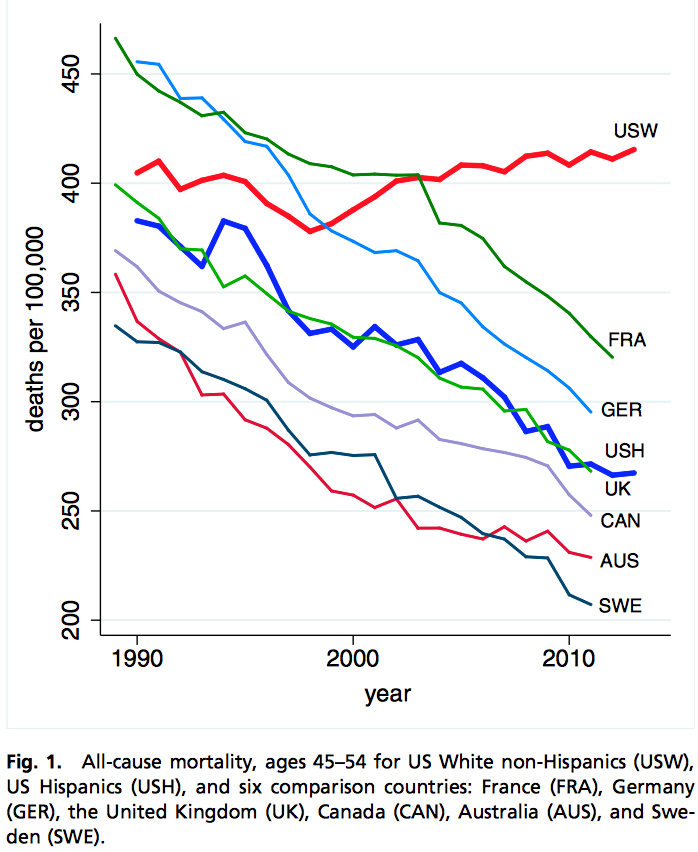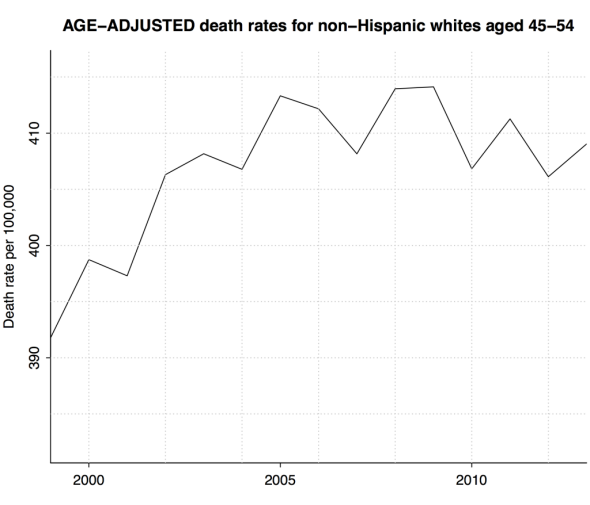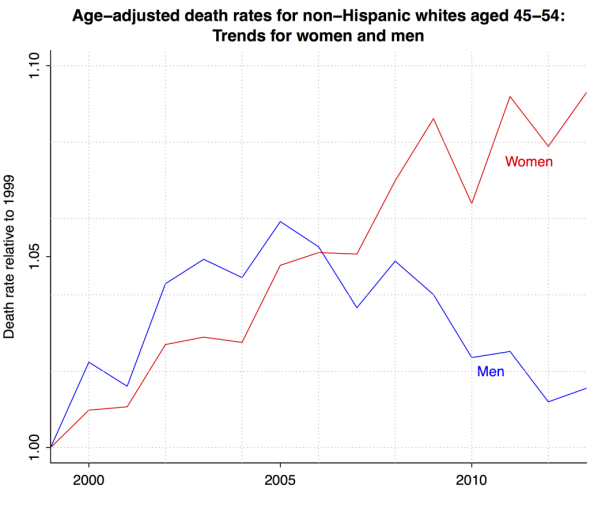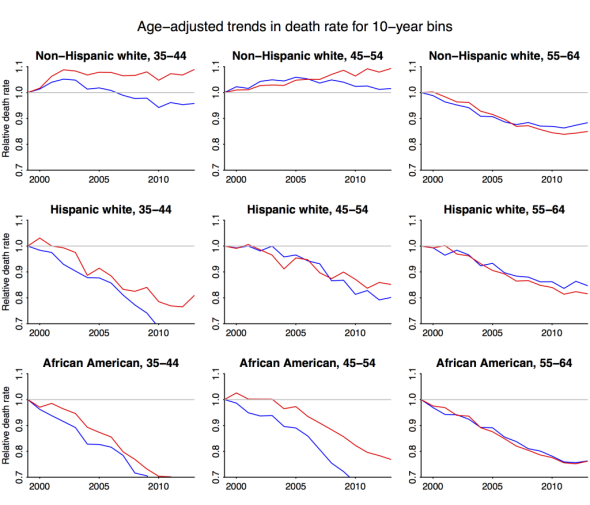今天先讲个论文故事,然后讨论下科研领域正在发生的信息化过程。
2015年,在《美国国家科学院院刊》(也就是PNAS)上发表了一篇论文,题目翻译过来是《提升中的21世纪中年非拉美裔美国白人的患病率与死亡率》。文章对比了1999年到2013年美国非拉美裔白人及拉美裔白人及六个发达国家(包括法国、德国、英国、加拿大、澳大利亚、瑞典)45到54岁人群的死亡率,发现只有非拉美裔美国白人的死亡率是在上升的,在进一步分析了死亡原因后,作者发现毒品、酒精中毒、自杀还有慢性肝硬化可能主导这种上升,同时教育水平越低,上升比例越快。
这是一篇对左派跟右派都有利的文章,左派认为是这些年福利政策减弱与传统宗教价值观的复兴造成的,加上这一段算是共和党小布什的主要执政期,自然锅是右派的。有意思的是,右派看到这个研究后也发话称这个锅恰恰是因为白人蓝领对工作、信仰还有家庭观念的缺失,而这个恰恰是传统宗教价值观所倡导的。好了我们不看左右互搏了,解释怎么来都行,但现象总该没问题吧?
有问题。文章发表不久,知名话痨兼统计学家 Andrew Gelman 教授 在自己博客上对这个研究的数据进行了重新分析,其实说“重新分析”是书面说法,真实的情况是对这一组数据进行了校正。因为 Gelman 教授注意到了一个简单到不能再简单的问题:你这个死亡率没有对年龄分布进行校正。
原始数据:

我来解释下这个校正,举例来说我有100个人年龄段在45到54岁,那么在这个15年的研究时间段里,每一年进入这个年龄段的人数应该是差不多一样的才好跟其他的地方去比。但恰恰这个年龄段包括了二战后的婴儿潮,也就是说,每年这个死亡率的基数在变,该年龄段整体平均年龄被拖大了,按照自然规律,年龄大本来就死亡率高。所以应该对每一年的数据除以其人数,也就是认为这个年龄段的人数应该差不多才合适。
校正后数据:

额,从这个结果上看那个上升趋势就不明显了。 Gelman 教授进一步分析了其他国家数据,发现其他国家同年龄段死亡率校正后还是一直下跌,那么美国非拉美裔中年白人比较诡异的死亡率确实是存在的,也就是说原文主要结论没啥问题。然后Gelman 教授又想到会不会性别上有差异?然后得到了下面这个图:

感情白人男性其实没怎么变,女性死亡率倒是一直在提高。然后Gelman 教授又计算了一下相对死亡率,用1999年为基准,看了下不同年龄段的分布:

结果发现不仅仅45-54岁女性非拉美裔白人死亡率在上升,35-44岁这个年龄段也在上升。那么问题来了,为什么当初不去说这个年龄段呢?会不会原文属于一种发表歧视呢?也就是说对比了半天终于发现了一个显著的,而其实如果在处理数据时男女分开,这篇报道的题目会不会就成了“35-54岁女性非拉美裔白人死亡率在上升”呢?
其实我讲这个故事对这个论文事实兴趣不大,我很好奇的是为什么这样的评论是以博客的形式出现的。传统学术界的交流一般依赖期刊论文与会议,但是动辄几个月的审稿时间是不是对成果交流的一种阻碍呢?诚然学术界绝大多数是要依赖出版物来获取声望,但其实有时候很多博客评论的深度与广度可能并不比3-5个审稿人的审稿意见低。
回到这个案例,原论文的作者在另一个科学博客里回应了质疑,她声称研究过程中确实也考察了性别影响,但没有使用相对死亡率,为了不让读者被一大堆图表覆盖就没放到文章里。同时针对Gelman教授的论点,她重新分析后认为吸烟与否对这个年龄段男性女性死亡率差异起了重要贡献。但是她又说了如下的话:
We spent a year working on this paper, sweating out every number, sweating out over what we were doing, and then to see people blogging about it in real time — that’s not the way science really gets done. . . . And so it’s a little hard for us to respond to all of the blog posts that are coming out. . . . And if this is all people shooting from the hip, I don’t think that’s any way to move science forward, to move the research forward.
也就是说,你们博客评论太草根,懒得理你。但数据的产生者或科学问题的提出者不应该同时也要是问题的正确解决者,有时候提供一个视角就很好了。可了解Gelman教授的人应该清楚,其哥伦比亚大学资深话唠身份不是白拿的,他马上就在博客上回应了这样一封应该来自作者的虚构的信来表明博客这种交流方式其实也应该被科研人员尊敬而不是故作清高姿态:
We spent a year working on this paper, sweating out every number, sweating out over what we were doing, and we’re happy to see see people blogging about it in real time.
We very much appreciate the effort put in by Laudan Aron, Lisa Dubay, Elaine Waxman, and Steven Martin, Philip Cohen, and Andrew Gelman to uncover the aggregation bias in our analysis, to correct for that bias, and to explore subtleties that we did not have a chance to get into in our paper. As Gelman noted, these corrections are in no way a debunking of our work—our comparisons of non-Hispanic American whites to groups in other countries and other ethnic groups still stand.
We think it’s great that, after our paper was published in PNAS, it was possible to get rapid feedback. Had it not been for bloggers, we’d still be in the awkward situation of people trying to trying to explain an increase in death rates which isn’t actually happening. We join Paul Krugman and Ross Douthat in thanking these bloggers for their unpaid efforts on the behalf of everyone interested in this research. We count ourselves lucky to live in an era in which mistakes can be corrected rapidly, so that we and others do not have to wait months or even years for published corrections which themselves could contain further errors.
As economists, we recognize that research work is always provisional, and that anyone studying the real world of human interactions has to accept that mistakes are part of the process. It is only through the efforts of our entire research community—publishing in journals, publishing in blogs, through informal conversations, whatever—that we move toward the truth. We always considered our PNAS paper to be just a single step in this process and we are glad that others have taken the trouble to correct some of our biases and omissions.
Again, we thank the many researchers who have taken a careful look at our analyses. It’s good to know that our main findings are not affected by the corrections, we welcome further research in this area, and we hope that future discussion of our work, both in the scientific literature and in the popular press, make use of the corrected, age-adjusted trends.
– Sincerely, Anne Case and Angus Deaton
P.S. We have heard some people criticize the researchers noted above because they published their work in blogs rather than in peer-reviewed journals. We would never make such a silly, uninformed criticism. Since appearing in print, our work has received a huge amount of publicity. And, to the extent that we made mistakes or did not happen to explain ourselves clearly enough, it is the responsibility of others to publish their corrections and explanations as rapidly as possible. Blogs are a great way to do this. Blogs, unlike newspaper interviews, allow unlimited space to develop arguments and to present graphs of data. And we are of course aware that peer-reviewed journals make mistakes too. We published our paper in the Proceedings of the National Academy of Sciences, a journal that last year published a notorious paper on himmicanes and hurricanes, another discredited paper claiming certain behavior by people whose ages end in 9, and another paper on demographics which neglected to apply a basic age adjustment. So, yes, publication in journals is fine, but we very much welcome researchers who are willing to stick out their necks and correct the record in real time on blogs.
当然,Gelman教授的火爆脾气自然也会招来一些不满,但是我认为有些观点是很有益处的。
博客,作为一种快速的回应方式,理应被尊重,因为科学发展就是要依赖这样的过程才能快速进步。说白了,现代科学研究不再是躲在黑暗小实验室里的勤勉钻研,更应该是一个交流碰撞的过程。最近几年,预印本服务器已经在物理、计算机跟生命科学领域大力发展,很多科研报道的记者跟前沿课题组都盯着。同时,基于博客还有微博(当然不是你熟悉的那个娱乐版)对科研成果的讨论也逐渐成为一种风气。数据共享、媒体传播、在线学术档案也逐渐成为青年科学家累积学术声誉、寻找业界合作的方法。严肃的学术讨论可以发生在任何地方,态度而不是场景产生严肃感。我们可以逐渐看到:
- 大量高质量的问答、博文及报告幻灯片共享其实正在自发地形成一本本最新的网络教材
- 计算机领域里最新的算法很快就会有博文告诉你如何去用并出现一个对应的github repo
- 这边刚上传了一个物种基因组数据,那边某课题组集群上的自动化脚本就能生成一份报告email到课题组成员的邮箱里
- 微博上传阅的最新研究成果很快就被reddit上的匿名专家进行了通俗化解读与评论并发现了新现象
- 某公司苦苦追寻的最新技术操作过程竟然在直播平台被前沿科研人员作为论文发表的一部分所展示
- 某个博士生意外收到某大牛课题组长的报告邀请,只因为他读了这个学生的博客,感觉他对某个领域的理解很有特色
- ……
你可以躲在象牙塔里不知道,但这一切都在发生,或许它目前不“正式”,但解决科学问题更应该依赖快速的良性公开交流而不是论文被发表,那终归只是个起点,现代化的科研方式正在兴起。